Business Management Assignment: Accounting and Financial Analysis
VerifiedAdded on 2023/04/21
|11
|1515
|392
Homework Assignment
AI Summary
This document presents a detailed solution to a business management assignment, addressing key accounting and financial concepts. The assignment covers topics such as accrual accounting, depreciation methods (straight-line and reducing balance), and the impact of cash-based accounting. It includes calculations for depreciation charges, analysis of financial statements, and an examination of credit control systems. Furthermore, the solution provides insights into managing receivables and payables, along with a reflection on the learning process from a previous assignment. The student demonstrates an understanding of accounting principles, financial analysis, and the importance of effective financial controls, making this a valuable resource for students studying business management.
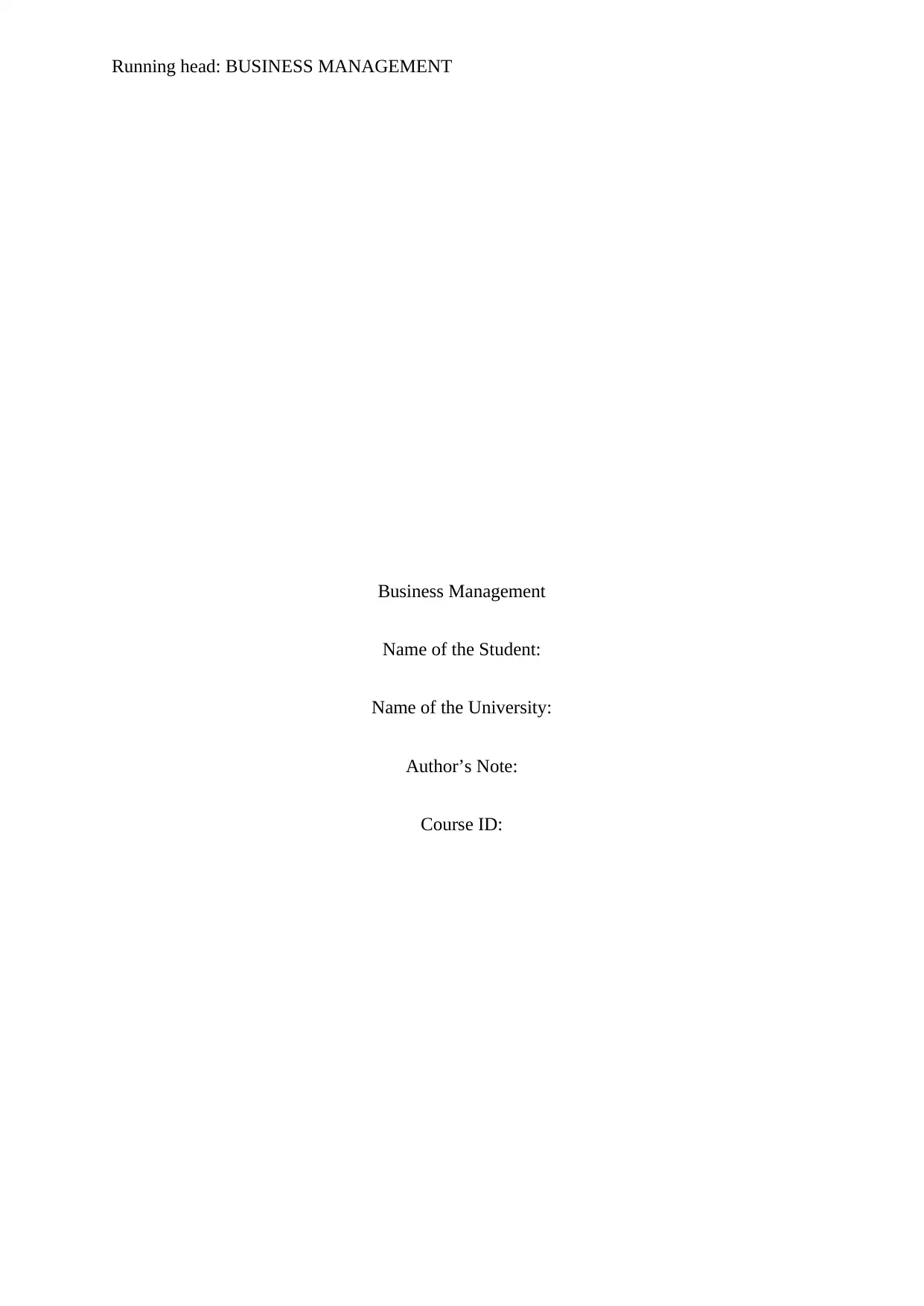
Running head: BUSINESS MANAGEMENT
Business Management
Name of the Student:
Name of the University:
Author’s Note:
Course ID:
Business Management
Name of the Student:
Name of the University:
Author’s Note:
Course ID:
Paraphrase This Document
Need a fresh take? Get an instant paraphrase of this document with our AI Paraphraser
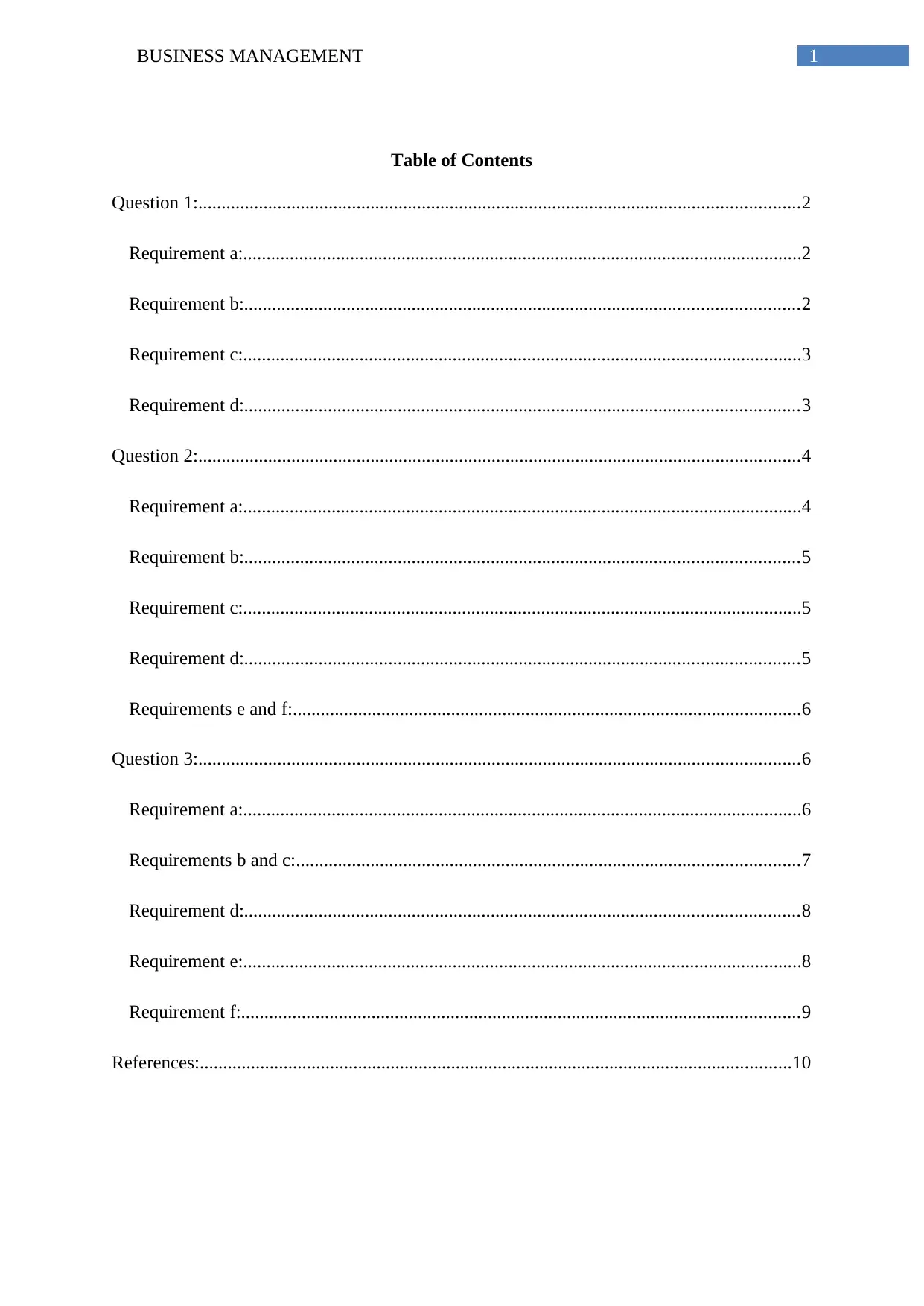
1BUSINESS MANAGEMENT
Table of Contents
Question 1:.................................................................................................................................2
Requirement a:........................................................................................................................2
Requirement b:.......................................................................................................................2
Requirement c:........................................................................................................................3
Requirement d:.......................................................................................................................3
Question 2:.................................................................................................................................4
Requirement a:........................................................................................................................4
Requirement b:.......................................................................................................................5
Requirement c:........................................................................................................................5
Requirement d:.......................................................................................................................5
Requirements e and f:.............................................................................................................6
Question 3:.................................................................................................................................6
Requirement a:........................................................................................................................6
Requirements b and c:............................................................................................................7
Requirement d:.......................................................................................................................8
Requirement e:........................................................................................................................8
Requirement f:........................................................................................................................9
References:...............................................................................................................................10
Table of Contents
Question 1:.................................................................................................................................2
Requirement a:........................................................................................................................2
Requirement b:.......................................................................................................................2
Requirement c:........................................................................................................................3
Requirement d:.......................................................................................................................3
Question 2:.................................................................................................................................4
Requirement a:........................................................................................................................4
Requirement b:.......................................................................................................................5
Requirement c:........................................................................................................................5
Requirement d:.......................................................................................................................5
Requirements e and f:.............................................................................................................6
Question 3:.................................................................................................................................6
Requirement a:........................................................................................................................6
Requirements b and c:............................................................................................................7
Requirement d:.......................................................................................................................8
Requirement e:........................................................................................................................8
Requirement f:........................................................................................................................9
References:...............................................................................................................................10
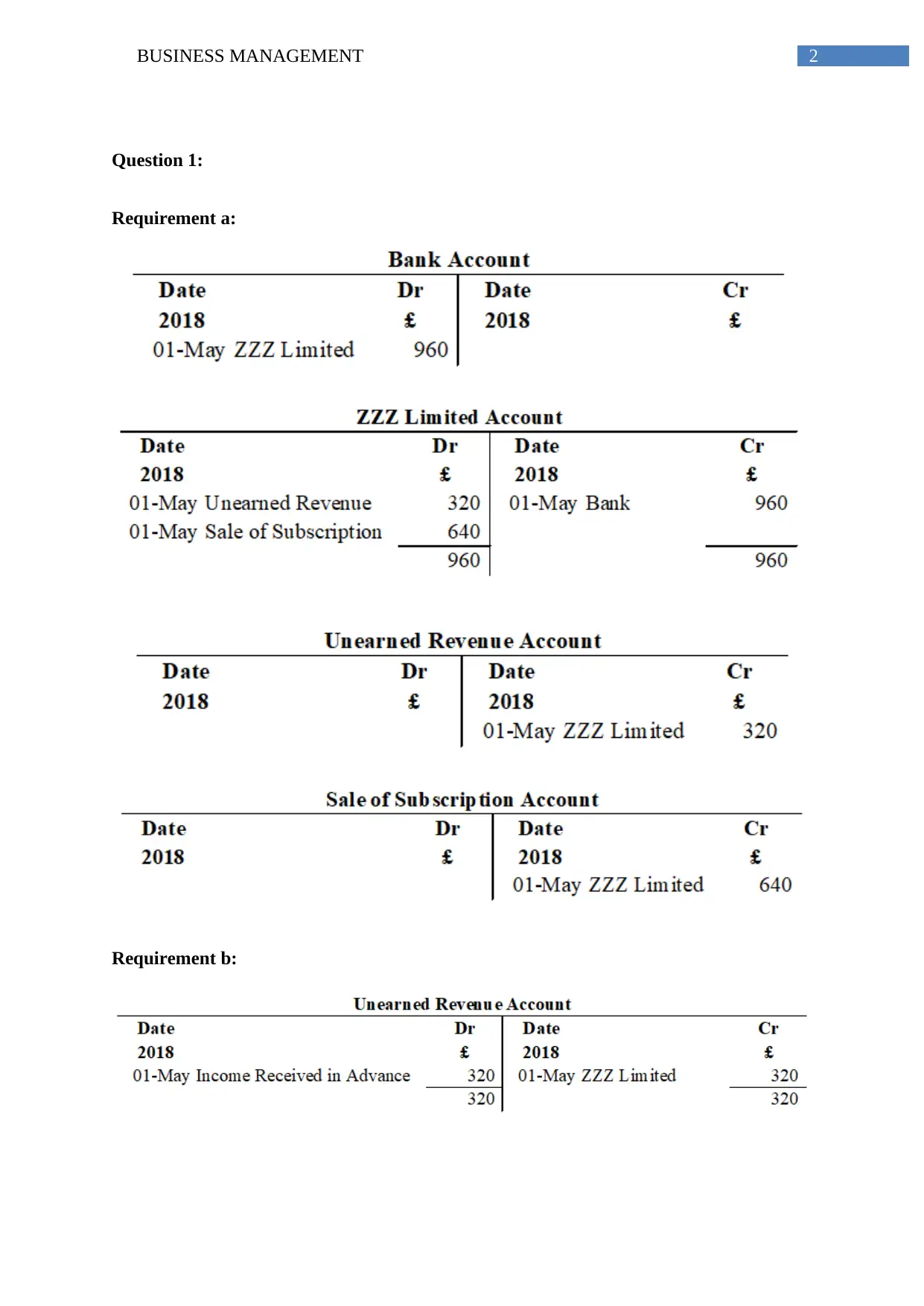
2BUSINESS MANAGEMENT
Question 1:
Requirement a:
Requirement b:
Question 1:
Requirement a:
Requirement b:
⊘ This is a preview!⊘
Do you want full access?
Subscribe today to unlock all pages.

Trusted by 1+ million students worldwide
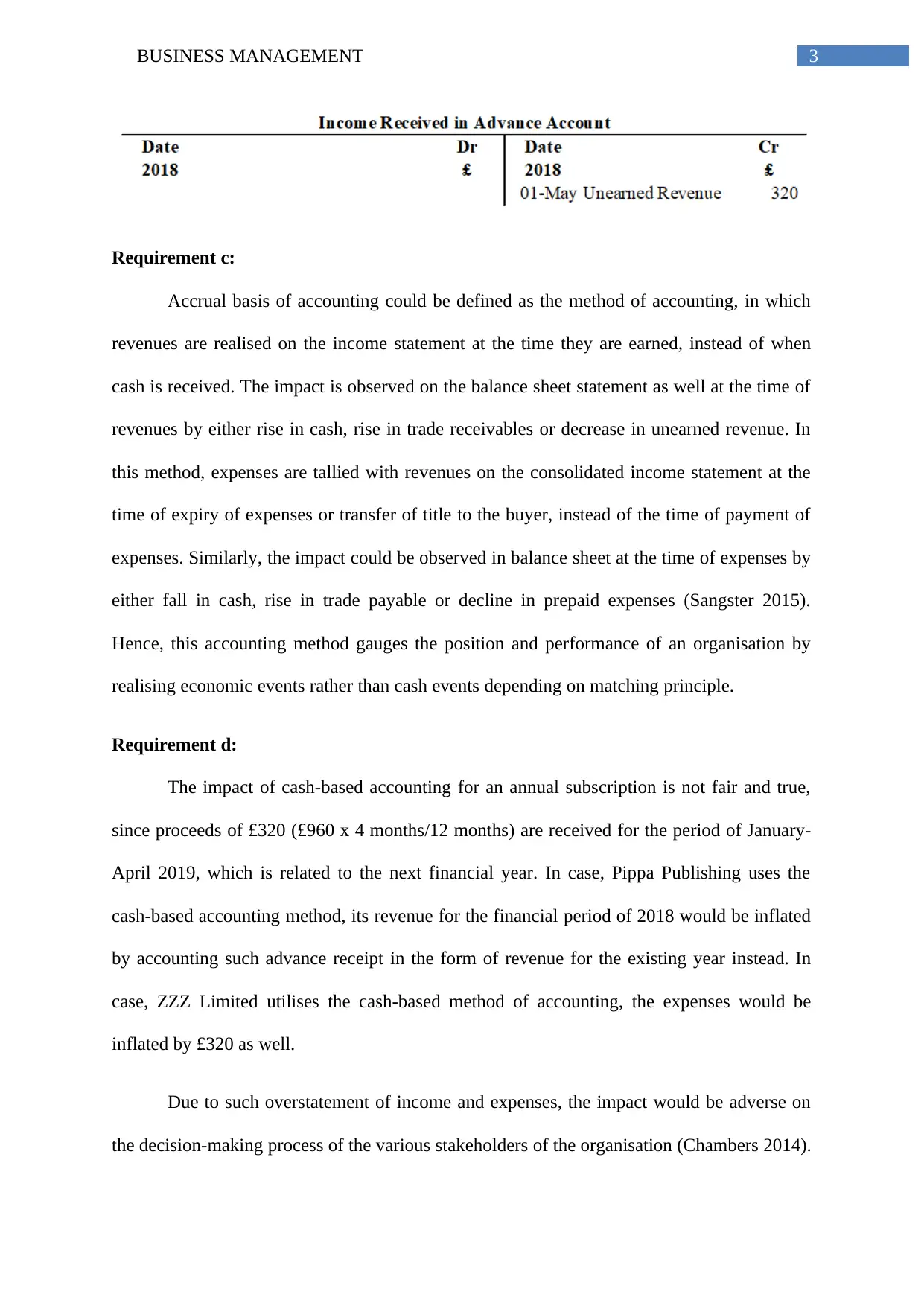
3BUSINESS MANAGEMENT
Requirement c:
Accrual basis of accounting could be defined as the method of accounting, in which
revenues are realised on the income statement at the time they are earned, instead of when
cash is received. The impact is observed on the balance sheet statement as well at the time of
revenues by either rise in cash, rise in trade receivables or decrease in unearned revenue. In
this method, expenses are tallied with revenues on the consolidated income statement at the
time of expiry of expenses or transfer of title to the buyer, instead of the time of payment of
expenses. Similarly, the impact could be observed in balance sheet at the time of expenses by
either fall in cash, rise in trade payable or decline in prepaid expenses (Sangster 2015).
Hence, this accounting method gauges the position and performance of an organisation by
realising economic events rather than cash events depending on matching principle.
Requirement d:
The impact of cash-based accounting for an annual subscription is not fair and true,
since proceeds of £320 (£960 x 4 months/12 months) are received for the period of January-
April 2019, which is related to the next financial year. In case, Pippa Publishing uses the
cash-based accounting method, its revenue for the financial period of 2018 would be inflated
by accounting such advance receipt in the form of revenue for the existing year instead. In
case, ZZZ Limited utilises the cash-based method of accounting, the expenses would be
inflated by £320 as well.
Due to such overstatement of income and expenses, the impact would be adverse on
the decision-making process of the various stakeholders of the organisation (Chambers 2014).
Requirement c:
Accrual basis of accounting could be defined as the method of accounting, in which
revenues are realised on the income statement at the time they are earned, instead of when
cash is received. The impact is observed on the balance sheet statement as well at the time of
revenues by either rise in cash, rise in trade receivables or decrease in unearned revenue. In
this method, expenses are tallied with revenues on the consolidated income statement at the
time of expiry of expenses or transfer of title to the buyer, instead of the time of payment of
expenses. Similarly, the impact could be observed in balance sheet at the time of expenses by
either fall in cash, rise in trade payable or decline in prepaid expenses (Sangster 2015).
Hence, this accounting method gauges the position and performance of an organisation by
realising economic events rather than cash events depending on matching principle.
Requirement d:
The impact of cash-based accounting for an annual subscription is not fair and true,
since proceeds of £320 (£960 x 4 months/12 months) are received for the period of January-
April 2019, which is related to the next financial year. In case, Pippa Publishing uses the
cash-based accounting method, its revenue for the financial period of 2018 would be inflated
by accounting such advance receipt in the form of revenue for the existing year instead. In
case, ZZZ Limited utilises the cash-based method of accounting, the expenses would be
inflated by £320 as well.
Due to such overstatement of income and expenses, the impact would be adverse on
the decision-making process of the various stakeholders of the organisation (Chambers 2014).
Paraphrase This Document
Need a fresh take? Get an instant paraphrase of this document with our AI Paraphraser
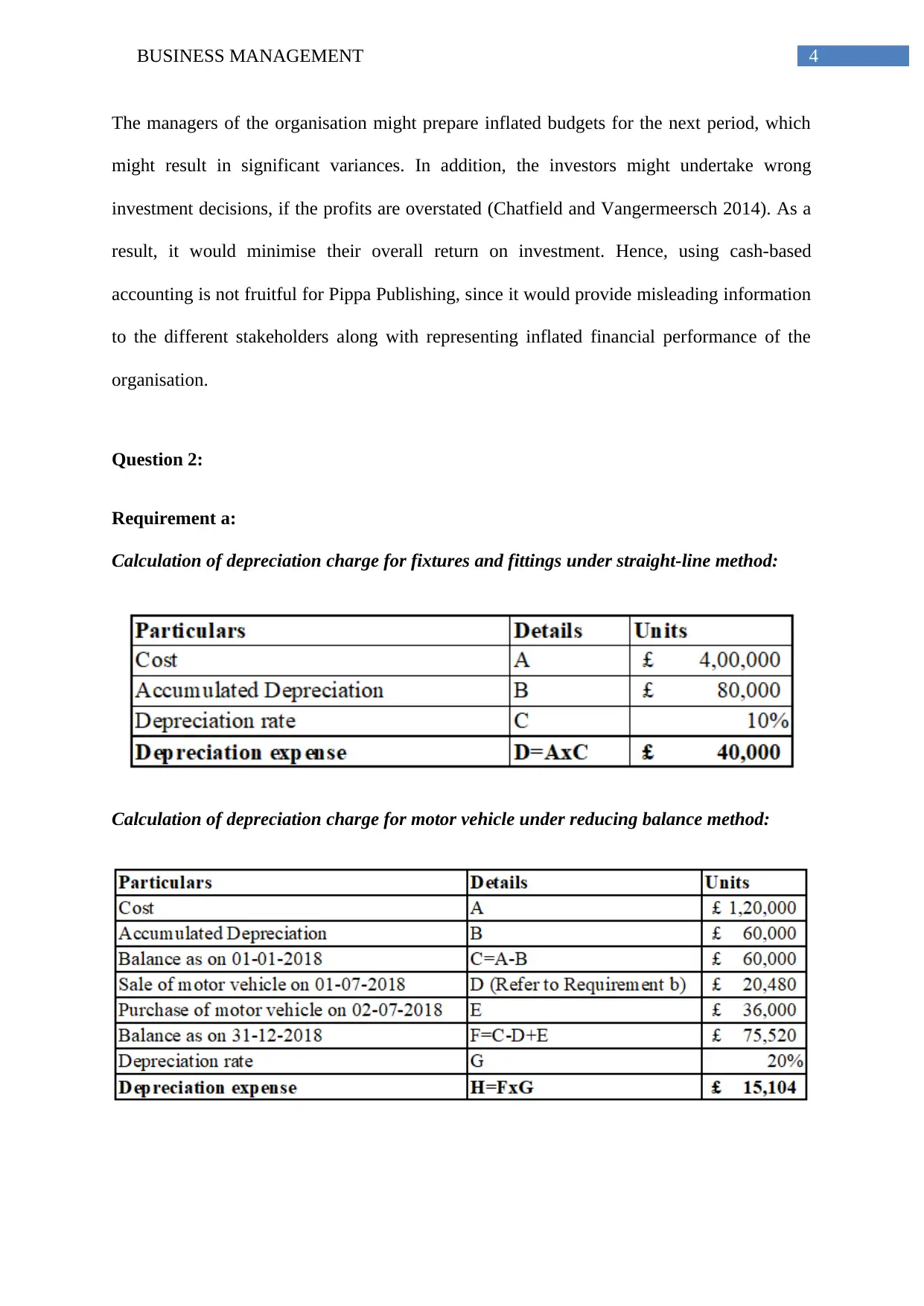
4BUSINESS MANAGEMENT
The managers of the organisation might prepare inflated budgets for the next period, which
might result in significant variances. In addition, the investors might undertake wrong
investment decisions, if the profits are overstated (Chatfield and Vangermeersch 2014). As a
result, it would minimise their overall return on investment. Hence, using cash-based
accounting is not fruitful for Pippa Publishing, since it would provide misleading information
to the different stakeholders along with representing inflated financial performance of the
organisation.
Question 2:
Requirement a:
Calculation of depreciation charge for fixtures and fittings under straight-line method:
Calculation of depreciation charge for motor vehicle under reducing balance method:
The managers of the organisation might prepare inflated budgets for the next period, which
might result in significant variances. In addition, the investors might undertake wrong
investment decisions, if the profits are overstated (Chatfield and Vangermeersch 2014). As a
result, it would minimise their overall return on investment. Hence, using cash-based
accounting is not fruitful for Pippa Publishing, since it would provide misleading information
to the different stakeholders along with representing inflated financial performance of the
organisation.
Question 2:
Requirement a:
Calculation of depreciation charge for fixtures and fittings under straight-line method:
Calculation of depreciation charge for motor vehicle under reducing balance method:
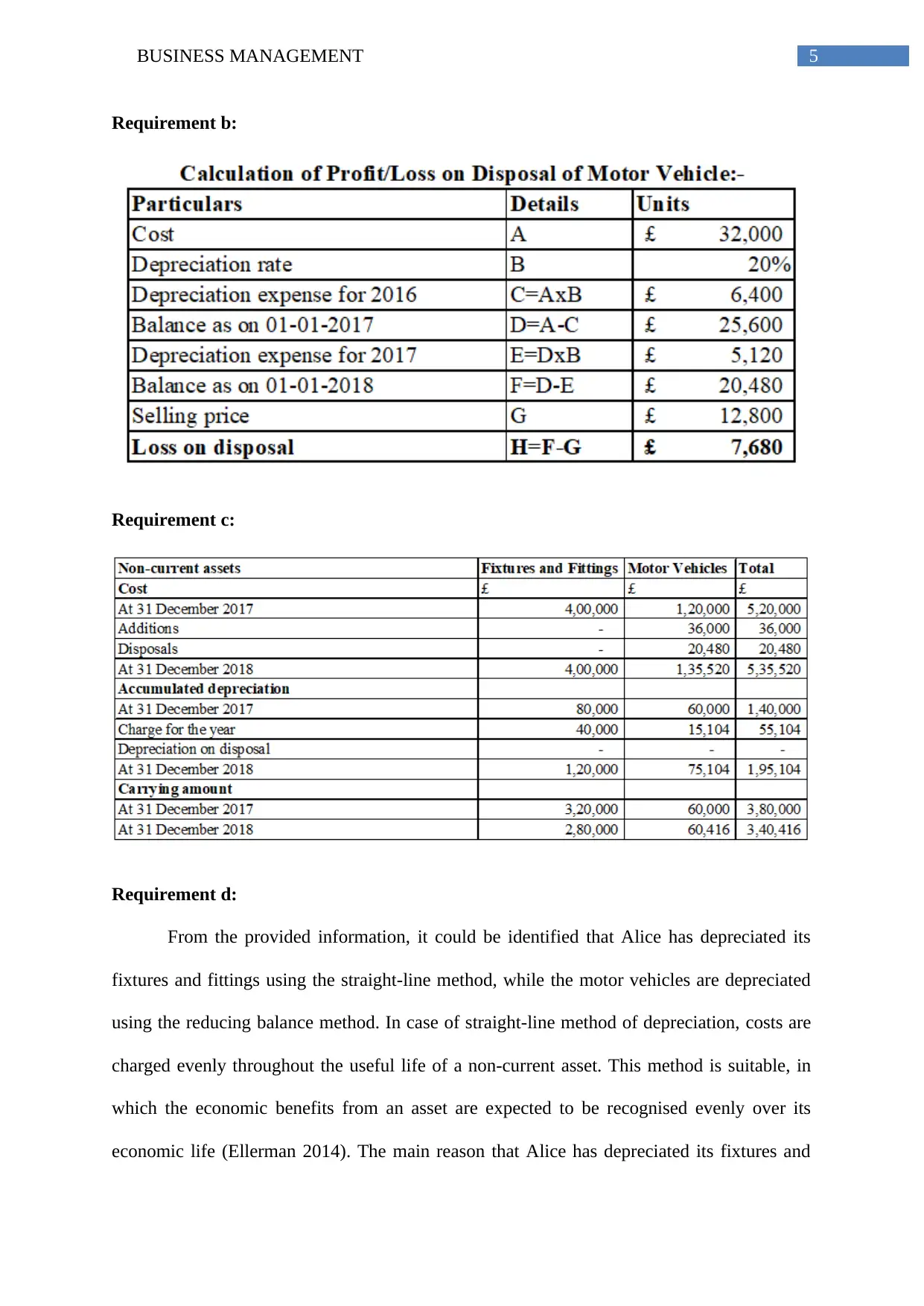
5BUSINESS MANAGEMENT
Requirement b:
Requirement c:
Requirement d:
From the provided information, it could be identified that Alice has depreciated its
fixtures and fittings using the straight-line method, while the motor vehicles are depreciated
using the reducing balance method. In case of straight-line method of depreciation, costs are
charged evenly throughout the useful life of a non-current asset. This method is suitable, in
which the economic benefits from an asset are expected to be recognised evenly over its
economic life (Ellerman 2014). The main reason that Alice has depreciated its fixtures and
Requirement b:
Requirement c:
Requirement d:
From the provided information, it could be identified that Alice has depreciated its
fixtures and fittings using the straight-line method, while the motor vehicles are depreciated
using the reducing balance method. In case of straight-line method of depreciation, costs are
charged evenly throughout the useful life of a non-current asset. This method is suitable, in
which the economic benefits from an asset are expected to be recognised evenly over its
economic life (Ellerman 2014). The main reason that Alice has depreciated its fixtures and
⊘ This is a preview!⊘
Do you want full access?
Subscribe today to unlock all pages.

Trusted by 1+ million students worldwide
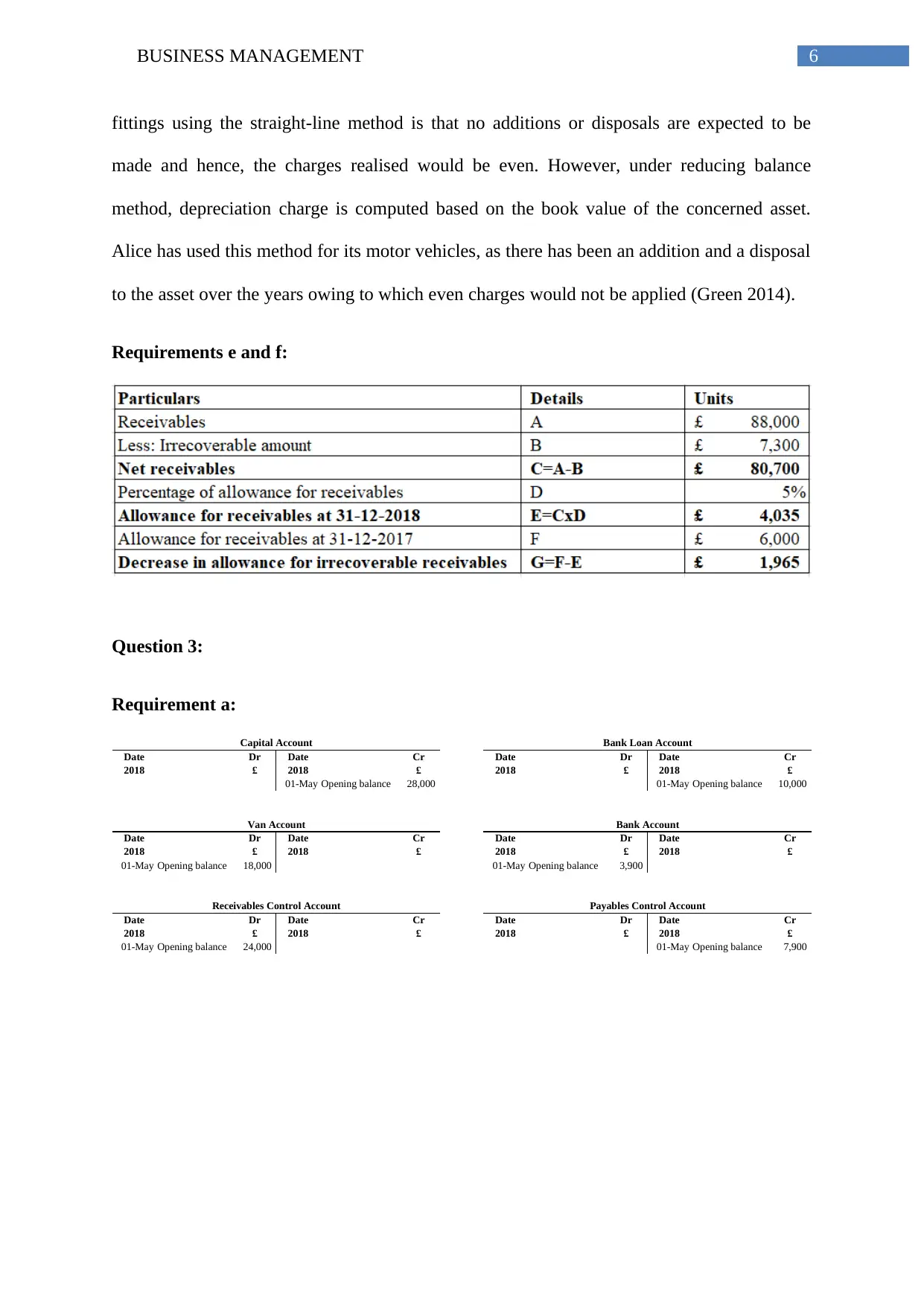
6BUSINESS MANAGEMENT
fittings using the straight-line method is that no additions or disposals are expected to be
made and hence, the charges realised would be even. However, under reducing balance
method, depreciation charge is computed based on the book value of the concerned asset.
Alice has used this method for its motor vehicles, as there has been an addition and a disposal
to the asset over the years owing to which even charges would not be applied (Green 2014).
Requirements e and f:
Question 3:
Requirement a:
Date Dr Date Cr Date Dr Date Cr
2018 £ 2018 £ 2018 £ 2018 £
01-May Opening balance 28,000 01-May Opening balance 10,000
Date Dr Date Cr Date Dr Date Cr
2018 £ 2018 £ 2018 £ 2018 £
01-May Opening balance 18,000 01-May Opening balance 3,900
Date Dr Date Cr Date Dr Date Cr
2018 £ 2018 £ 2018 £ 2018 £
01-May Opening balance 24,000 01-May Opening balance 7,900
Capital Account Bank Loan Account
Van Account Bank Account
Receivables Control Account Payables Control Account
fittings using the straight-line method is that no additions or disposals are expected to be
made and hence, the charges realised would be even. However, under reducing balance
method, depreciation charge is computed based on the book value of the concerned asset.
Alice has used this method for its motor vehicles, as there has been an addition and a disposal
to the asset over the years owing to which even charges would not be applied (Green 2014).
Requirements e and f:
Question 3:
Requirement a:
Date Dr Date Cr Date Dr Date Cr
2018 £ 2018 £ 2018 £ 2018 £
01-May Opening balance 28,000 01-May Opening balance 10,000
Date Dr Date Cr Date Dr Date Cr
2018 £ 2018 £ 2018 £ 2018 £
01-May Opening balance 18,000 01-May Opening balance 3,900
Date Dr Date Cr Date Dr Date Cr
2018 £ 2018 £ 2018 £ 2018 £
01-May Opening balance 24,000 01-May Opening balance 7,900
Capital Account Bank Loan Account
Van Account Bank Account
Receivables Control Account Payables Control Account
Paraphrase This Document
Need a fresh take? Get an instant paraphrase of this document with our AI Paraphraser
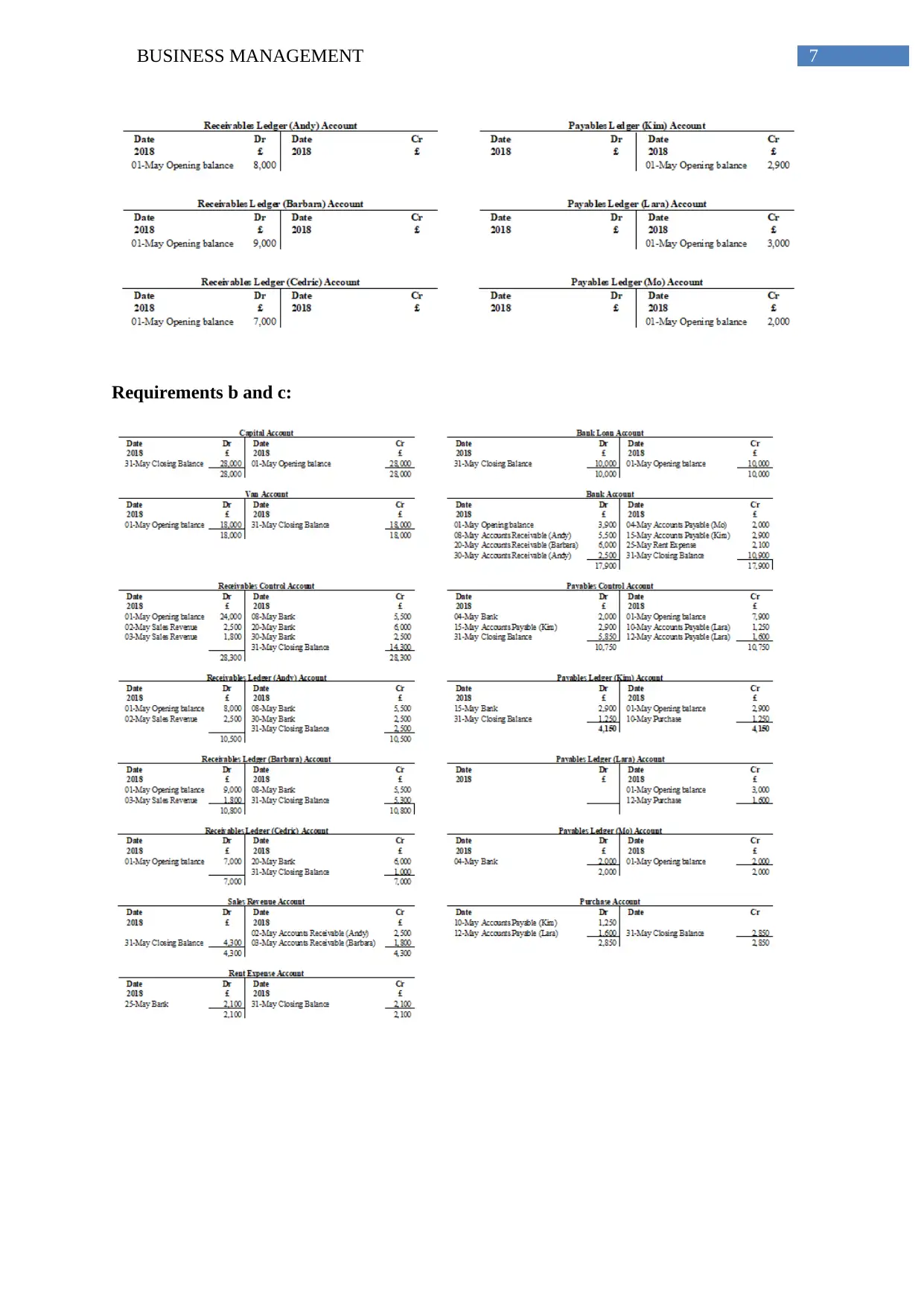
7BUSINESS MANAGEMENT
Requirements b and c:
Requirements b and c:
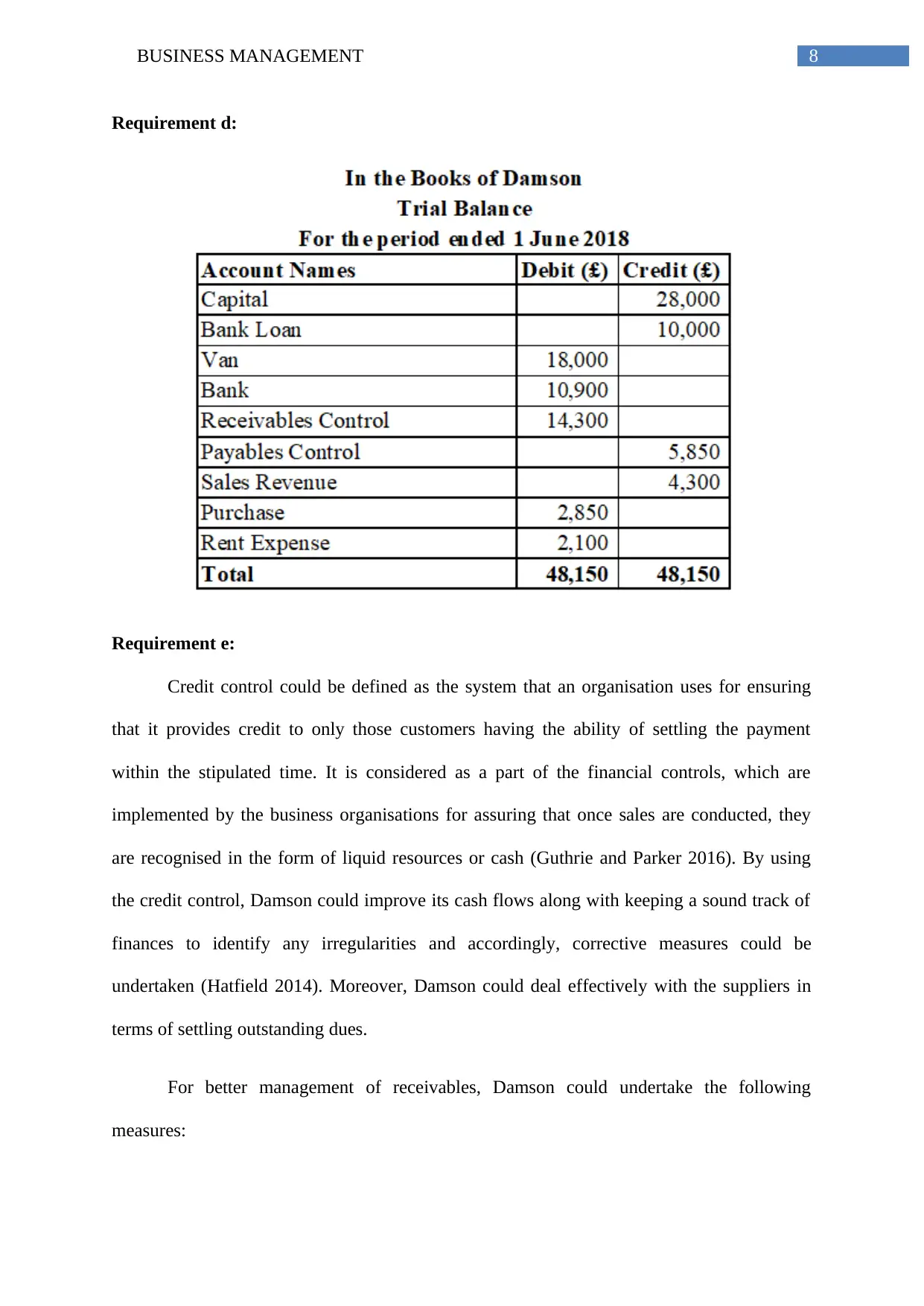
8BUSINESS MANAGEMENT
Requirement d:
Requirement e:
Credit control could be defined as the system that an organisation uses for ensuring
that it provides credit to only those customers having the ability of settling the payment
within the stipulated time. It is considered as a part of the financial controls, which are
implemented by the business organisations for assuring that once sales are conducted, they
are recognised in the form of liquid resources or cash (Guthrie and Parker 2016). By using
the credit control, Damson could improve its cash flows along with keeping a sound track of
finances to identify any irregularities and accordingly, corrective measures could be
undertaken (Hatfield 2014). Moreover, Damson could deal effectively with the suppliers in
terms of settling outstanding dues.
For better management of receivables, Damson could undertake the following
measures:
Requirement d:
Requirement e:
Credit control could be defined as the system that an organisation uses for ensuring
that it provides credit to only those customers having the ability of settling the payment
within the stipulated time. It is considered as a part of the financial controls, which are
implemented by the business organisations for assuring that once sales are conducted, they
are recognised in the form of liquid resources or cash (Guthrie and Parker 2016). By using
the credit control, Damson could improve its cash flows along with keeping a sound track of
finances to identify any irregularities and accordingly, corrective measures could be
undertaken (Hatfield 2014). Moreover, Damson could deal effectively with the suppliers in
terms of settling outstanding dues.
For better management of receivables, Damson could undertake the following
measures:
⊘ This is a preview!⊘
Do you want full access?
Subscribe today to unlock all pages.

Trusted by 1+ million students worldwide
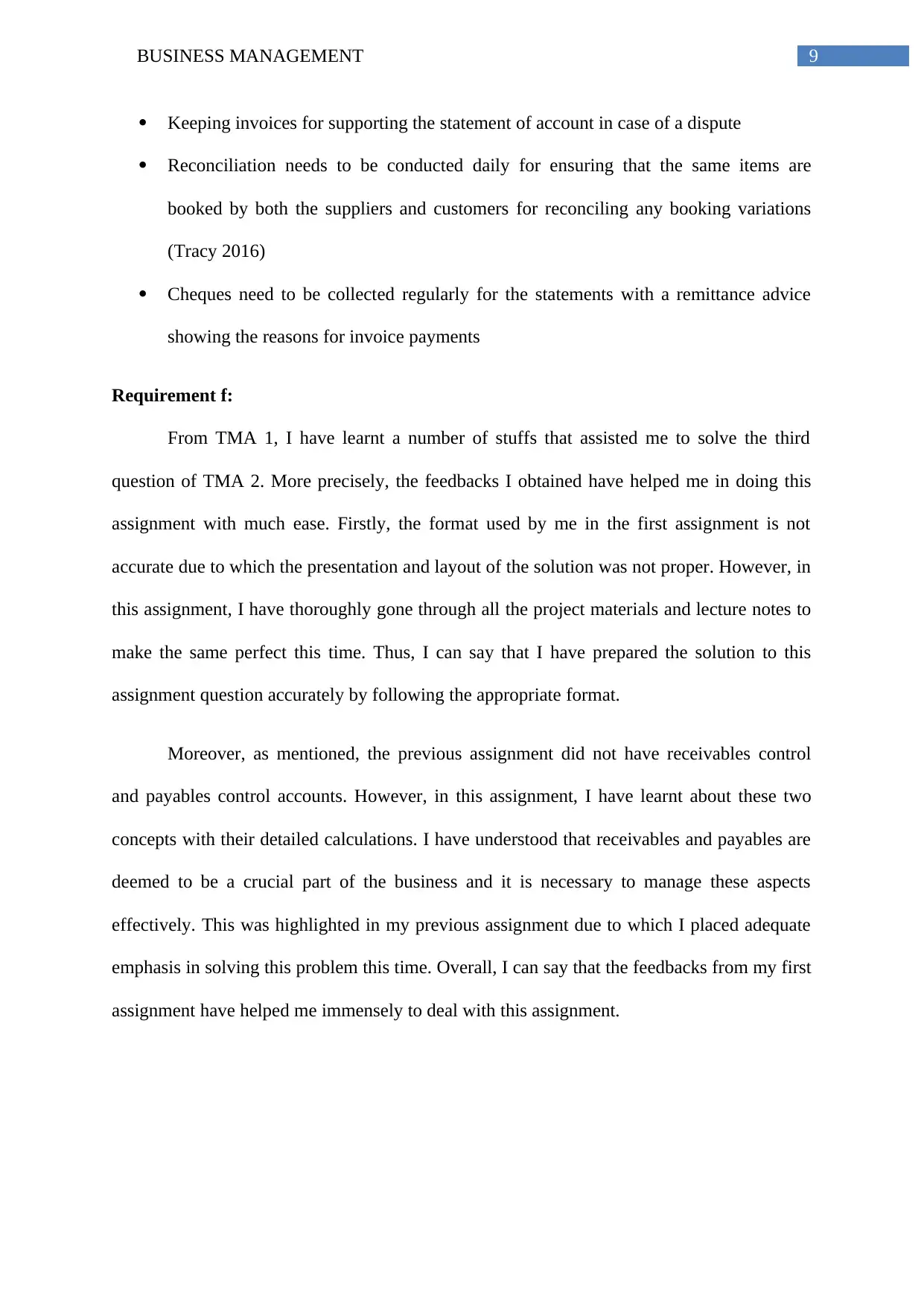
9BUSINESS MANAGEMENT
Keeping invoices for supporting the statement of account in case of a dispute
Reconciliation needs to be conducted daily for ensuring that the same items are
booked by both the suppliers and customers for reconciling any booking variations
(Tracy 2016)
Cheques need to be collected regularly for the statements with a remittance advice
showing the reasons for invoice payments
Requirement f:
From TMA 1, I have learnt a number of stuffs that assisted me to solve the third
question of TMA 2. More precisely, the feedbacks I obtained have helped me in doing this
assignment with much ease. Firstly, the format used by me in the first assignment is not
accurate due to which the presentation and layout of the solution was not proper. However, in
this assignment, I have thoroughly gone through all the project materials and lecture notes to
make the same perfect this time. Thus, I can say that I have prepared the solution to this
assignment question accurately by following the appropriate format.
Moreover, as mentioned, the previous assignment did not have receivables control
and payables control accounts. However, in this assignment, I have learnt about these two
concepts with their detailed calculations. I have understood that receivables and payables are
deemed to be a crucial part of the business and it is necessary to manage these aspects
effectively. This was highlighted in my previous assignment due to which I placed adequate
emphasis in solving this problem this time. Overall, I can say that the feedbacks from my first
assignment have helped me immensely to deal with this assignment.
Keeping invoices for supporting the statement of account in case of a dispute
Reconciliation needs to be conducted daily for ensuring that the same items are
booked by both the suppliers and customers for reconciling any booking variations
(Tracy 2016)
Cheques need to be collected regularly for the statements with a remittance advice
showing the reasons for invoice payments
Requirement f:
From TMA 1, I have learnt a number of stuffs that assisted me to solve the third
question of TMA 2. More precisely, the feedbacks I obtained have helped me in doing this
assignment with much ease. Firstly, the format used by me in the first assignment is not
accurate due to which the presentation and layout of the solution was not proper. However, in
this assignment, I have thoroughly gone through all the project materials and lecture notes to
make the same perfect this time. Thus, I can say that I have prepared the solution to this
assignment question accurately by following the appropriate format.
Moreover, as mentioned, the previous assignment did not have receivables control
and payables control accounts. However, in this assignment, I have learnt about these two
concepts with their detailed calculations. I have understood that receivables and payables are
deemed to be a crucial part of the business and it is necessary to manage these aspects
effectively. This was highlighted in my previous assignment due to which I placed adequate
emphasis in solving this problem this time. Overall, I can say that the feedbacks from my first
assignment have helped me immensely to deal with this assignment.
Paraphrase This Document
Need a fresh take? Get an instant paraphrase of this document with our AI Paraphraser
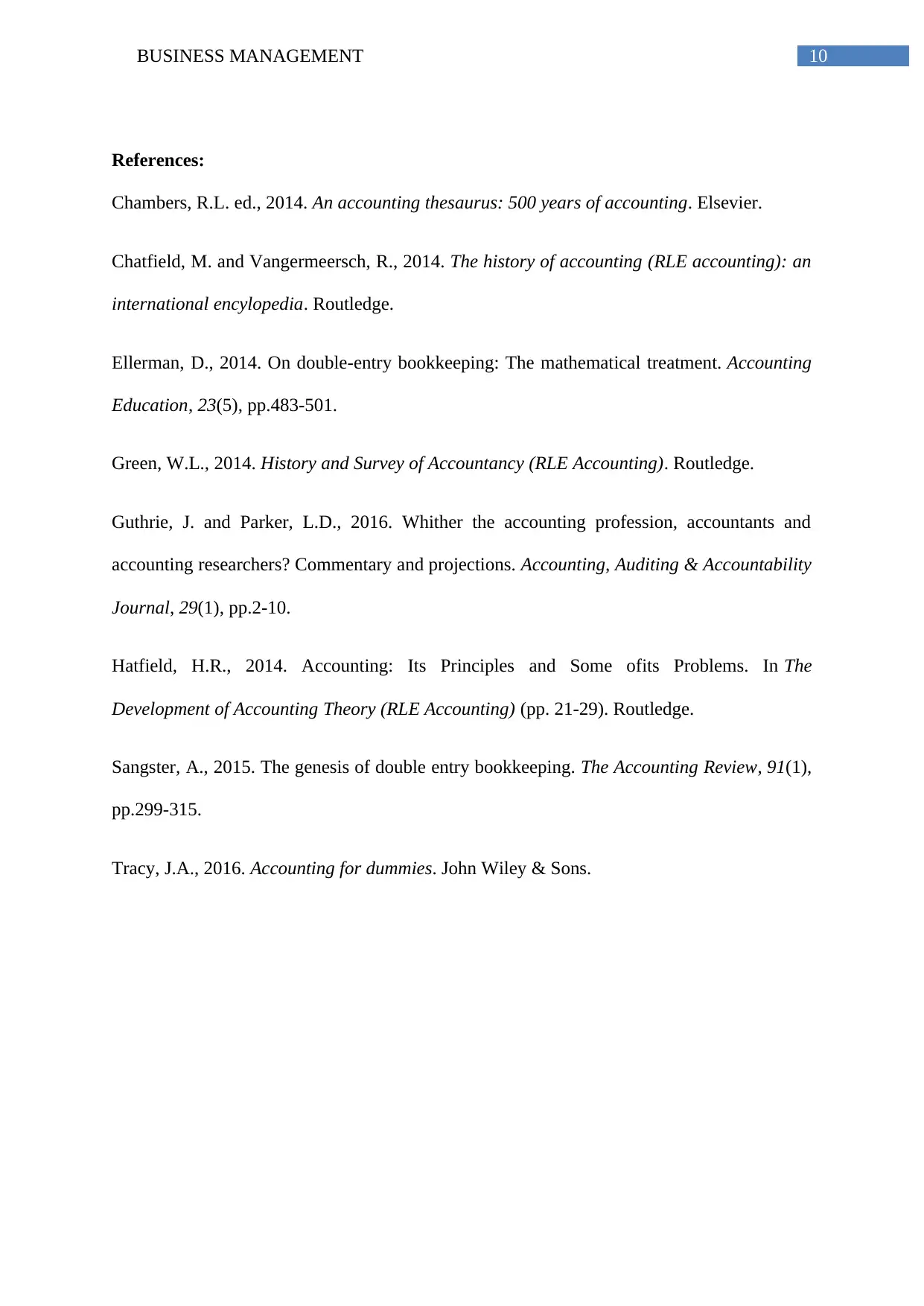
10BUSINESS MANAGEMENT
References:
Chambers, R.L. ed., 2014. An accounting thesaurus: 500 years of accounting. Elsevier.
Chatfield, M. and Vangermeersch, R., 2014. The history of accounting (RLE accounting): an
international encylopedia. Routledge.
Ellerman, D., 2014. On double-entry bookkeeping: The mathematical treatment. Accounting
Education, 23(5), pp.483-501.
Green, W.L., 2014. History and Survey of Accountancy (RLE Accounting). Routledge.
Guthrie, J. and Parker, L.D., 2016. Whither the accounting profession, accountants and
accounting researchers? Commentary and projections. Accounting, Auditing & Accountability
Journal, 29(1), pp.2-10.
Hatfield, H.R., 2014. Accounting: Its Principles and Some ofits Problems. In The
Development of Accounting Theory (RLE Accounting) (pp. 21-29). Routledge.
Sangster, A., 2015. The genesis of double entry bookkeeping. The Accounting Review, 91(1),
pp.299-315.
Tracy, J.A., 2016. Accounting for dummies. John Wiley & Sons.
References:
Chambers, R.L. ed., 2014. An accounting thesaurus: 500 years of accounting. Elsevier.
Chatfield, M. and Vangermeersch, R., 2014. The history of accounting (RLE accounting): an
international encylopedia. Routledge.
Ellerman, D., 2014. On double-entry bookkeeping: The mathematical treatment. Accounting
Education, 23(5), pp.483-501.
Green, W.L., 2014. History and Survey of Accountancy (RLE Accounting). Routledge.
Guthrie, J. and Parker, L.D., 2016. Whither the accounting profession, accountants and
accounting researchers? Commentary and projections. Accounting, Auditing & Accountability
Journal, 29(1), pp.2-10.
Hatfield, H.R., 2014. Accounting: Its Principles and Some ofits Problems. In The
Development of Accounting Theory (RLE Accounting) (pp. 21-29). Routledge.
Sangster, A., 2015. The genesis of double entry bookkeeping. The Accounting Review, 91(1),
pp.299-315.
Tracy, J.A., 2016. Accounting for dummies. John Wiley & Sons.
1 out of 11
Related Documents
Your All-in-One AI-Powered Toolkit for Academic Success.
+13062052269
info@desklib.com
Available 24*7 on WhatsApp / Email
![[object Object]](/_next/static/media/star-bottom.7253800d.svg)
Unlock your academic potential
Copyright © 2020–2025 A2Z Services. All Rights Reserved. Developed and managed by ZUCOL.





